Start Exploring Keyword Ideas
Use Serpstat to find the best keywords for your website
Mastering Content Briefs with AI: Faster, Easier, Better [+Template and Examples]
Practical guide to creating SEO content briefs using GPT-4 and Serpstat
![Mastering Content Briefs with AI: Faster, Easier, Better [+Template and Examples]](https://serpstat.com/files/img/44/uploadfile_1700397308_318.webp)

You should craft content briefs for your writers, creative team, or even for yourself if you want to design top-notch articles. But what makes a content brief truly effective?
While I'm not worried about AI replacing my job now, I am interested in exploring how editors can use AI writing tools to streamline the most repetitive tasks, such as content brief creation, and facilitate the generation of new ideas. Here's a closer look at such a collaboration of AI with a brief writer.
Understanding Content Briefs
In the digital marketing world, content is king, but even a king needs a plan to conquer the realm of search engines and captivate audiences.
An SEO content brief is a comprehensive document that provides detailed guidelines and specifications for crafting written content that is engaging, informative, and optimized for search engines. It ensures that the content adheres to specific technical standards, enhancing its potential to achieve higher rankings in search engine results.
A content brief is vital for crafting SEO-friendly content that performs well in search rankings. It should detail editorial direction and brand guidelines, clarifying the content's scope and objectives to ensure high-quality, consistent output. An effective SEO content brief should identify the target audience, define the brand's messaging style, place the content within the marketing funnel, address critical questions, give linking instructions, suggest titles and subheadings, and ensure topic comprehensiveness. Providing these details upfront can minimize miscommunication and streamline the revision process.
What Does a Brief Look Like? Content Marketing Briefs Examples
Creating content briefs involves iterating on your initial thoughts and exploring your creativity further. Below, you'll find four samples of briefs that can serve as foundational templates for your content development endeavors.
Let's begin with the first brief, which is designed to be clear and concise:
Source: SEO.ai
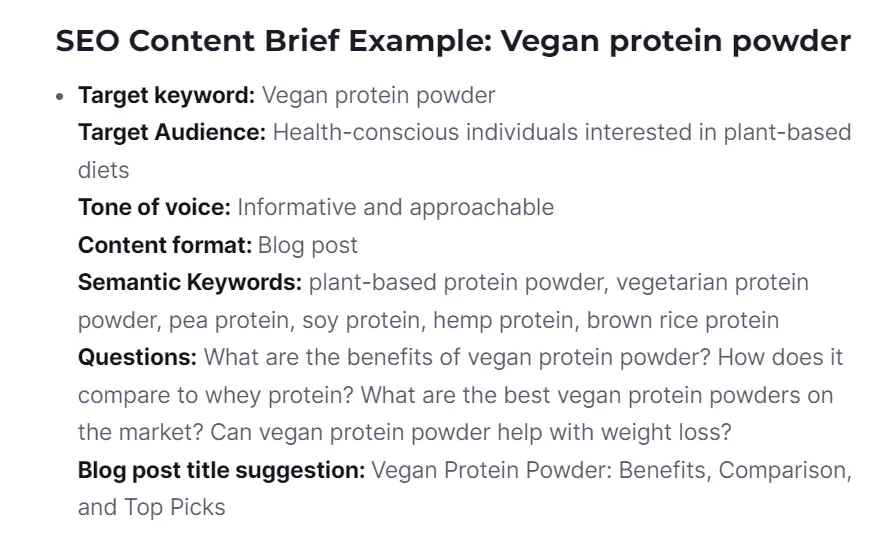
This basic brief type epitomizes simplicity, providing enough guidance to point the content creation in the right direction without overwhelming detail. It's ideal for seasoned writers familiar with the brand and SEO essentials.
The second type is a detailed, comprehensive brief that leaves no stone unturned, from audience insights to competitive analysis.
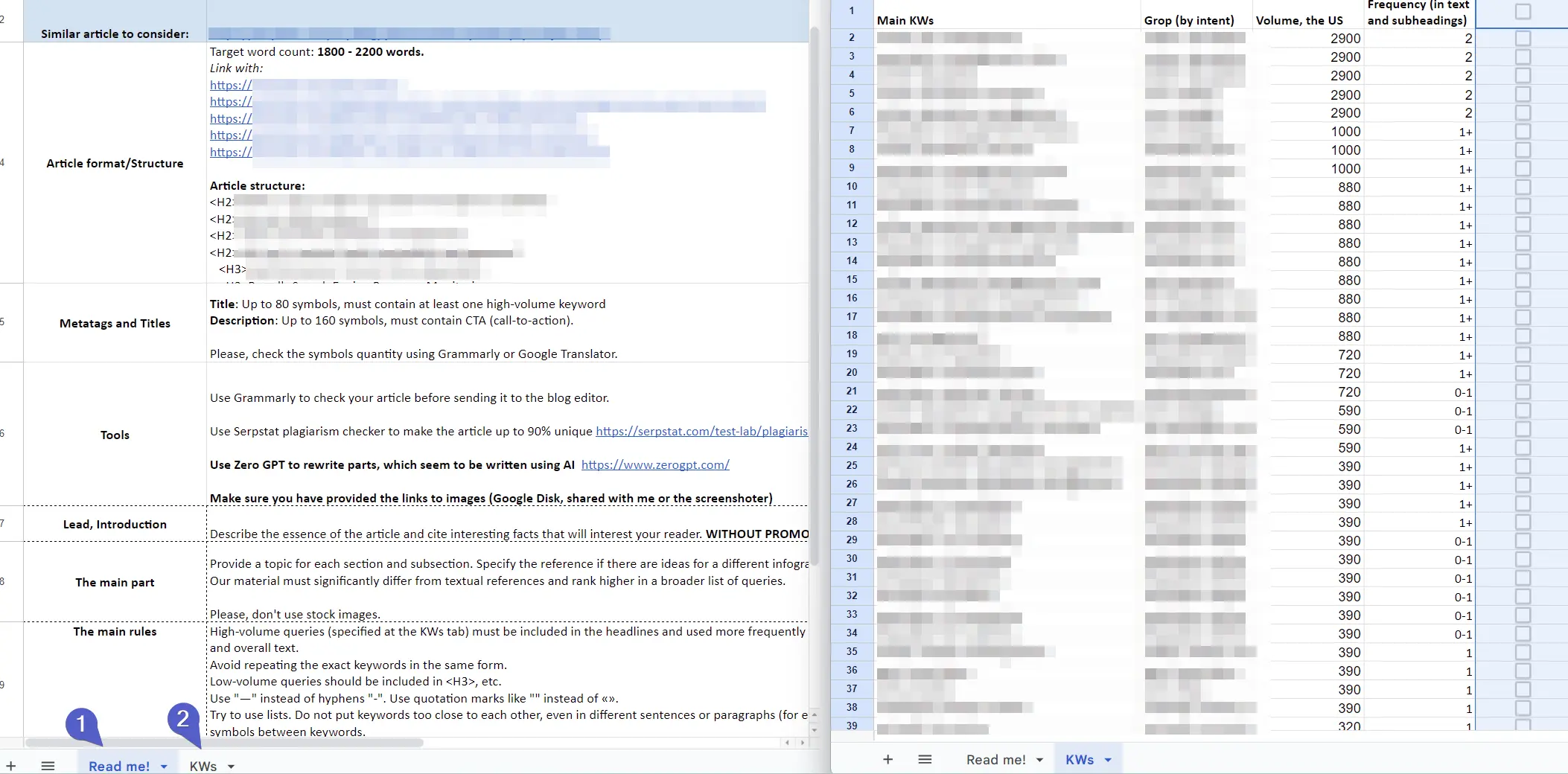
It's a roadmap that offers writers a full understanding of the content's purpose, scope, and desired outcome.
The third SEO content brief example is an analytically enhanced content brief. It has comprehensive data insights, including keyword efficacy, audience engagement patterns, and identified content opportunities. To further augment the precision of this brief, additional tools like Clearscope can be integrated.
Source: Clearscope
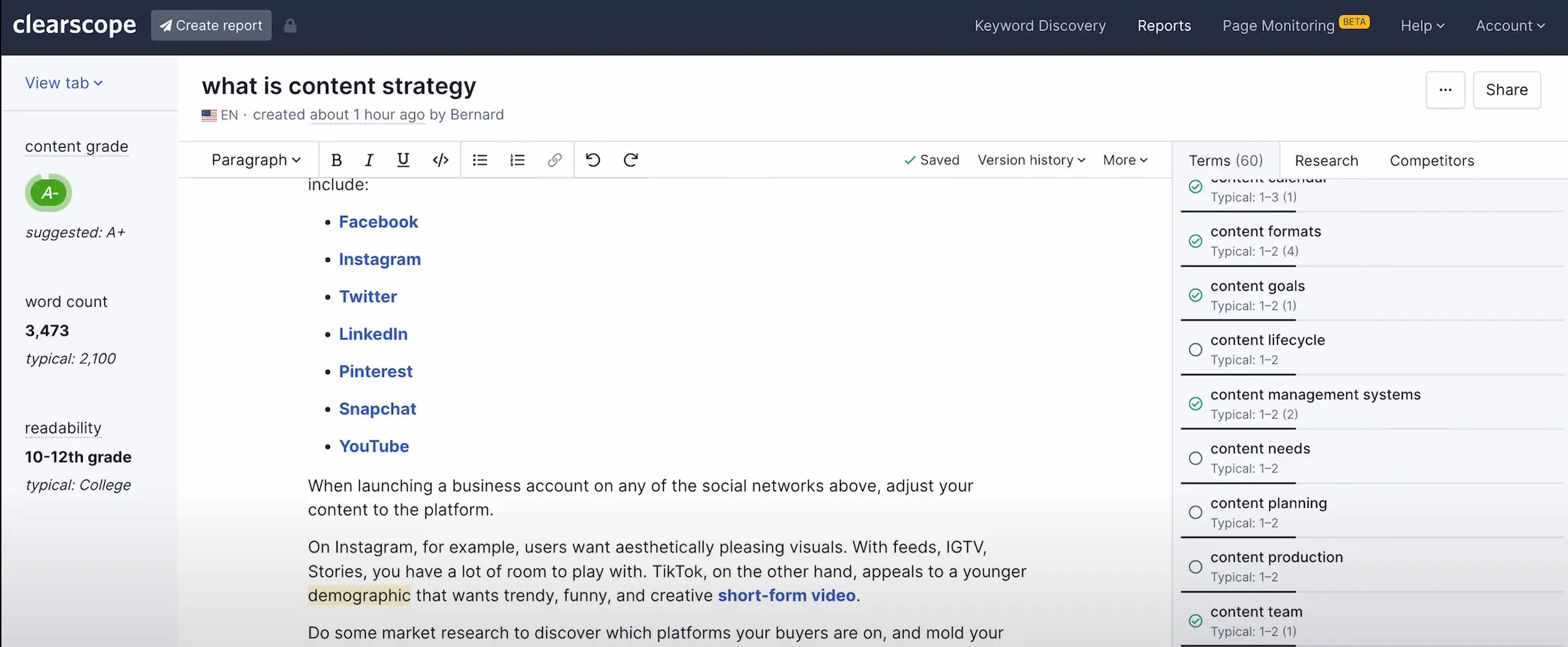
These tools bring an advanced level of content analysis, offering real-time content optimization recommendations. In some cases, Serpstat Text Analytics will be helpful as well. By using such tools, the brief becomes a dynamic document.
The last type is the creative briefs. A specific type of content needs the direct visual content development instructions.
Source: GatherContent
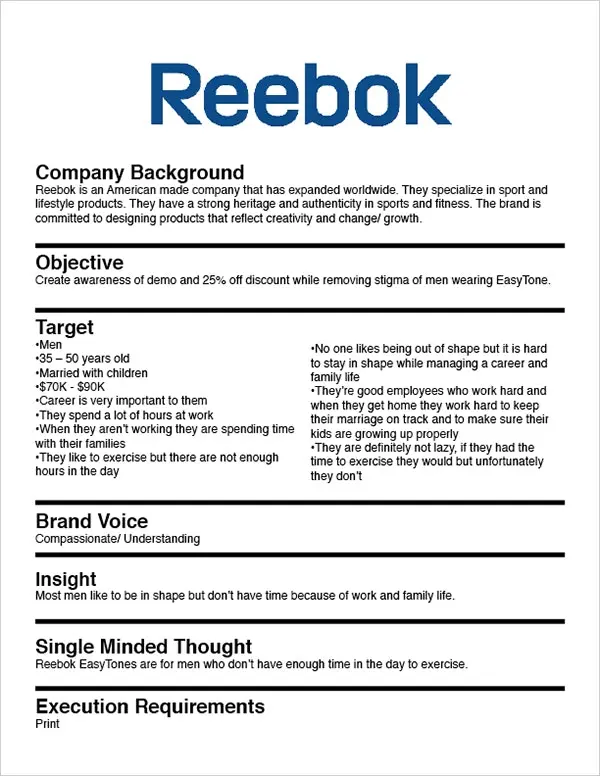
Unlike standard content briefs, which typically focus on written material, creative marketing briefs examples are used for crafting items such as videos, landing pages, covers, and infographics. Therefore, while they share a similar purpose in guiding content creation, creative and content briefs are distinct, with the former centering on visual rather than textual elements.
Following this, let's examine the basic layout of the content briefs to understand how these elements come together to form a practical blueprint for content creation.
Layout and Structure of the SEO Brief
SEO content briefs are crafted by brands aiming to boost organic search traffic via blog posts. They include essential details such as the intended audience, specific keywords, and the search intent behind those keywords, SERP analysis, and optimization strategies for the article. This type of content brief typically encompasses several critical elements:
- Word count. To determine the ideal length for your content, you should analyze the word count of top-ranking posts. This sets a benchmark for the desired comprehensiveness and depth of your article. You can manually check each page on the SERP or use tools and extensions for quicker analysis.
- Target keywords. These are the keywords you have to research. Integrating the keywords thoughtfully within your content aids search engines in discerning the subject matter of your page.
- On-page optimization. This aspect covers the technical components such as title tags, meta descriptions, and header tags (including H1 — H6), which are pivotal in imparting essential information to both users and search engines regarding the expectations from your content.
- Relevant topics and semantic associations. In SEO, it's beneficial to address related subtopics within your main content to create a rich, informative piece. Employing vocabulary and concepts that align with other authoritative content on similar topics can support your content's relevance and search engine ranking.
Content briefs should provide writers with the necessary instructions to produce content that adheres to both SEO best practices and resonates with readers.
How to Write a Content Brief
How can you create a content brief that effectively targets, engages, and converts your desired audience? Let's break down the essential pillars of creating such instructions as a cornerstone for content marketing strategies.
- In-depth audience analysis. True engagement starts with a profound understanding of your audience. What are their passions, challenges, and daily routines? By crafting detailed buyer personas using accurate analytics and insights, you ensure your content resonates deeper, forging a stronger connection with those you aim to reach.
- Strategic content objectives. Set SMART goals to steer your content toward tangible outcomes that align with your marketing ambitions. These goals act as your ‘North Star,’ guiding content's journey and measuring its impact upon arrival.
- Keyword mastery. A well-crafted content brief includes a harmonious blend of broad and industry keywords, ensuring your content stands out and reaches its intended audience.
- Cutting-edge tools. Using SEO and AI platforms can transform your content brief into a formidable asset, setting a new content standard.
Experience the transformative power yourself, not just on our say-so.
Elevate your content strategy by signing up for a 7-day free trial of Serpstat today!
Start the trialBlog Post Copywriting Brief Template
Using templates for content briefs is highly recommended. Starting from zero for each new content piece is inefficient – especially when crafting a thorough content brief is already quite an involved process.
This is the template for a brief that I regularly utilize in my work. Feel free to make a copy and adapt it for your own use.
Target audience and buyer personas
A content brief must pinpoint the target audience with specifics such as age, gender, location, and income. Crafting buyer personas or ideal customer profiles (ICPs) from real data is crucial. These brief notes on the audience's nature (tech-savvy or not) should be prominently placed at the start of the content brief for easy reference. You can talk about its mission, vision, or unique selling points. This is also helpful in writing CTAs.
Focus on providing insights that guide the writer's tone and depth, such as:
- The audience's familiarity with the subject. Is the content aimed at novices needing essential guidance or professionals seeking sophisticated insights?
- The reader's professional capacity. Does the target audience include technical specialists like software engineers or independent entrepreneurs?
If leading articles (top search results) are beginner-oriented, it might be wise for your content to cater to that same entry-level.
Keyword Research for Content Brief
When crafting SEO content, ensure your title aligns with the core purpose of your chosen keyword. This means it should directly address the searcher's needs, be a guide, a compilation of resources, or a collection of templates.
To gauge the intent behind your keywords, a swift Google search can be revealing. However, for insights into how this intent varies across different countries and to avoid personalized skewing results, use the Keyword Clustering feature in Serpstat. This should be done after gathering your primary seed keywords.
Keyword research for content brief, Serpstat
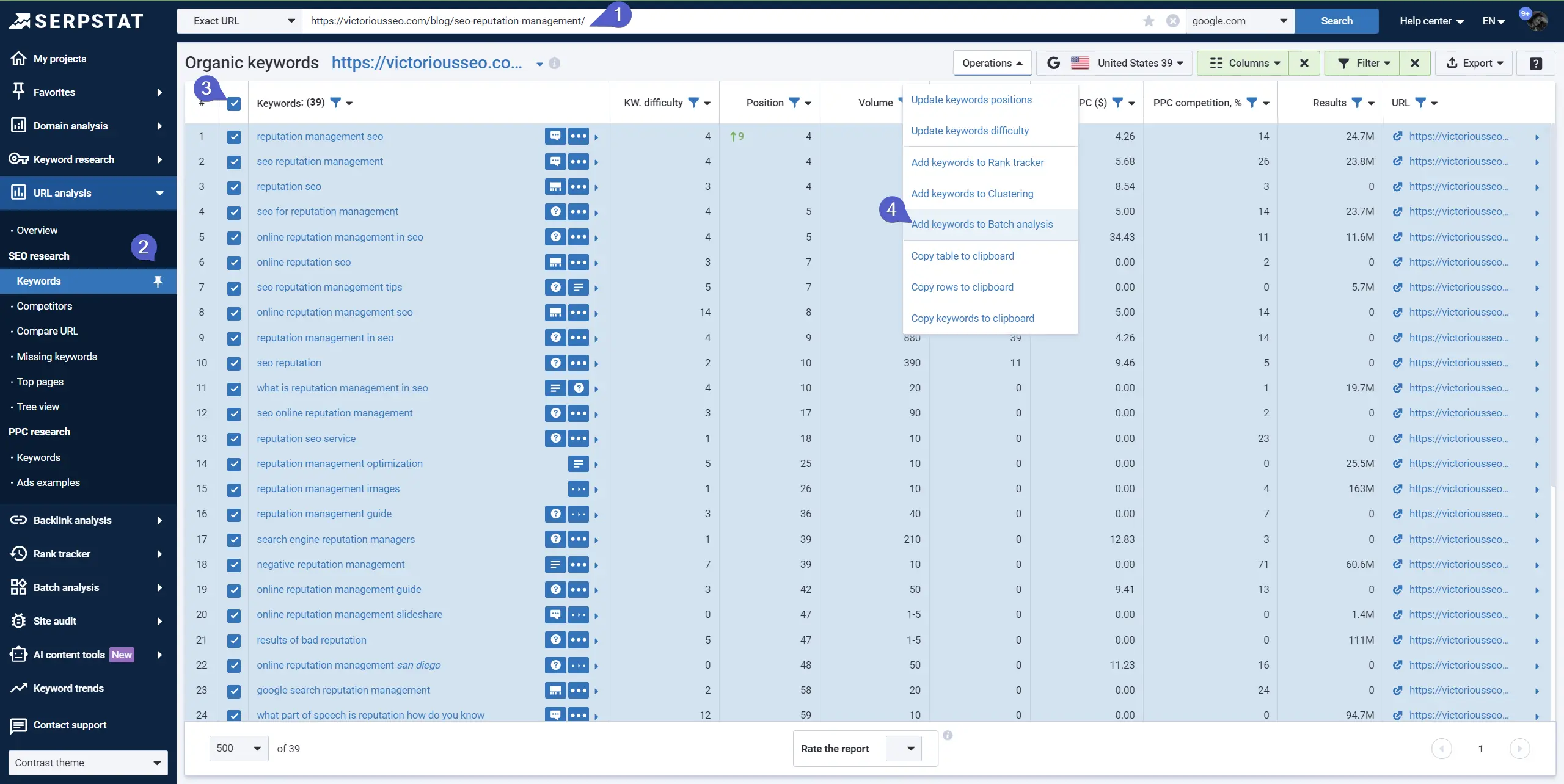
Then, run a clustering process (it might take up to a few hours, depending on the keywords quantity. Please, be patient :)).
Batch analysis, Serpstat
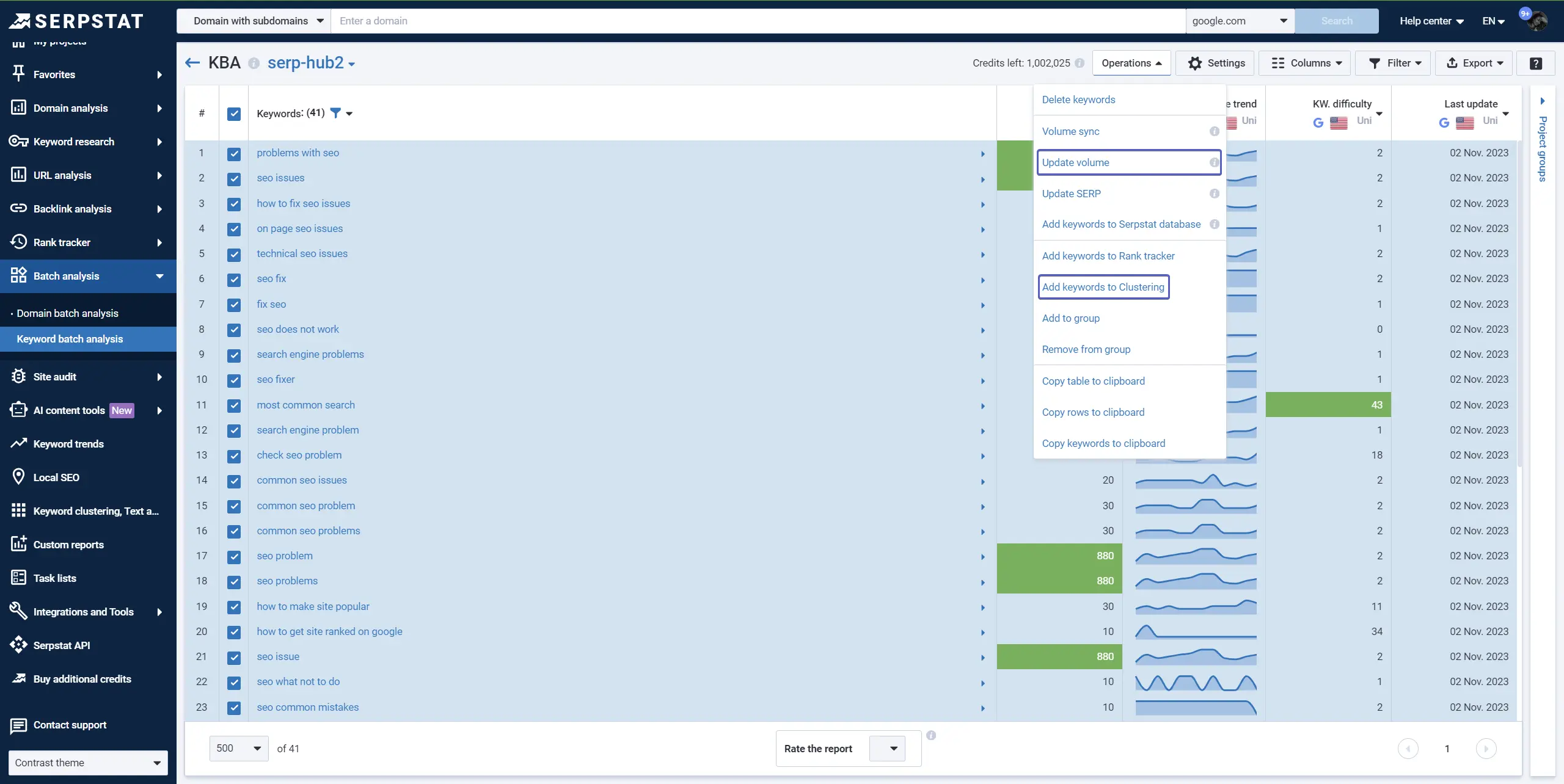
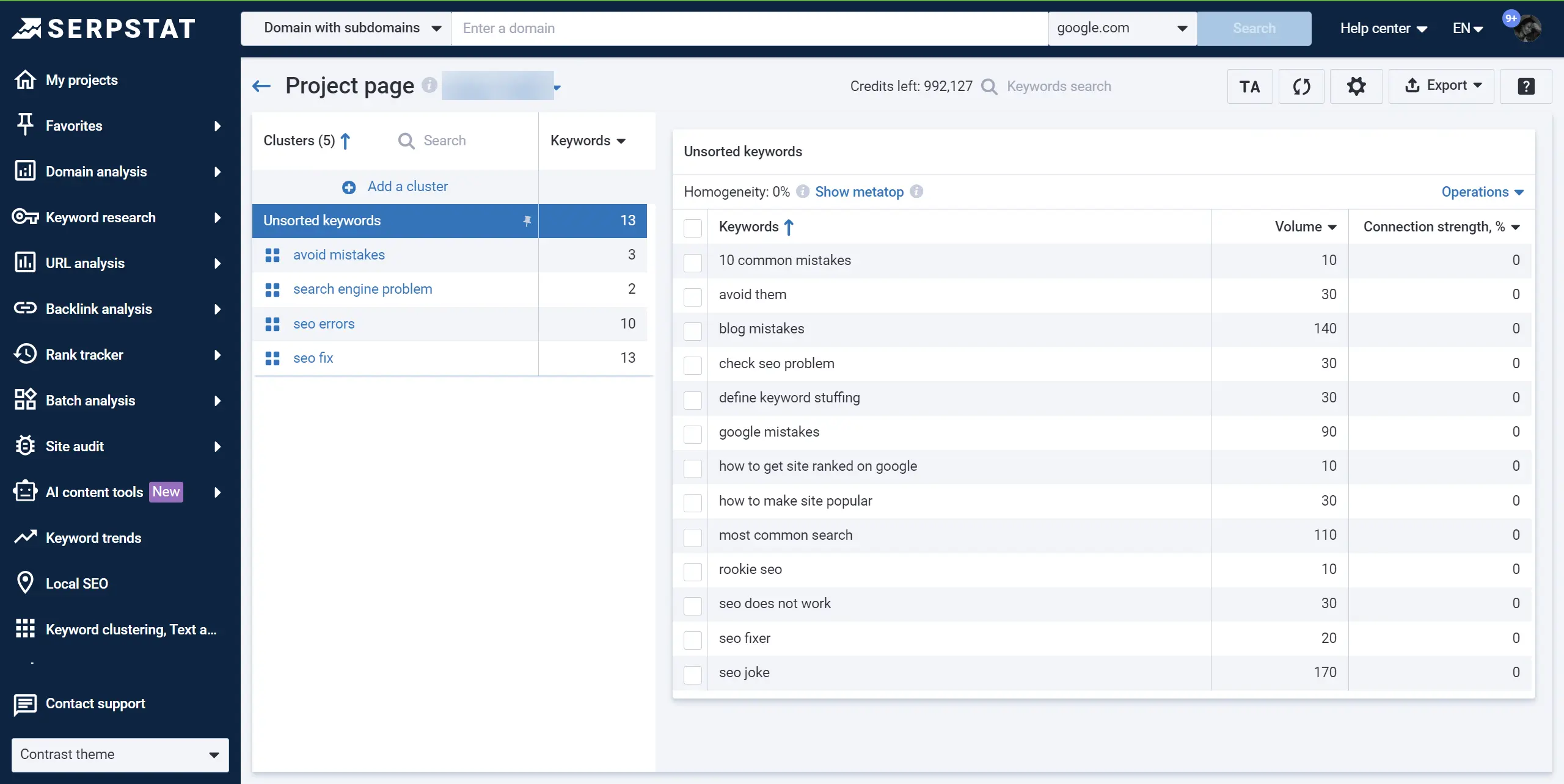
The keyword research reports usually provide three crucial metrics: search volume (the higher, the better), Keyword Difficulty (KD), with lower scores being more accessible to rank for, and search intent, which determines whether searchers are looking for information or product options. For increasing organic traffic, focus on keywords with high volume, low KD, and an informational intent.
Structure of the Article
A content brief should clearly outline the article's structure to guide copywriters effectively. Here's a condensed guide:
- Offer explicit, adaptable instructions for the article's framework, suitable for various industry standards.
- Segment the main body into subheadings representing a key point or argument.
- Under each subheading, specify the content and any crucial or unique details to include.
- Enhance the brief with examples and preferred writing styles for clarity.
- Assist your writer in understanding your product's relevance to the topic by explaining where it fits into the context and suggesting notable features to highlight.
Remember, a detailed and precise brief simplifies the writing process, ensuring the final content aligns with your vision.
Including a list of keywords that should be incorporated into headers and subheadings is good practice. This ensures that the content is structured in a reader-friendly way and optimized for search engines, enhancing the article's discoverability.
Source: Zenbrief
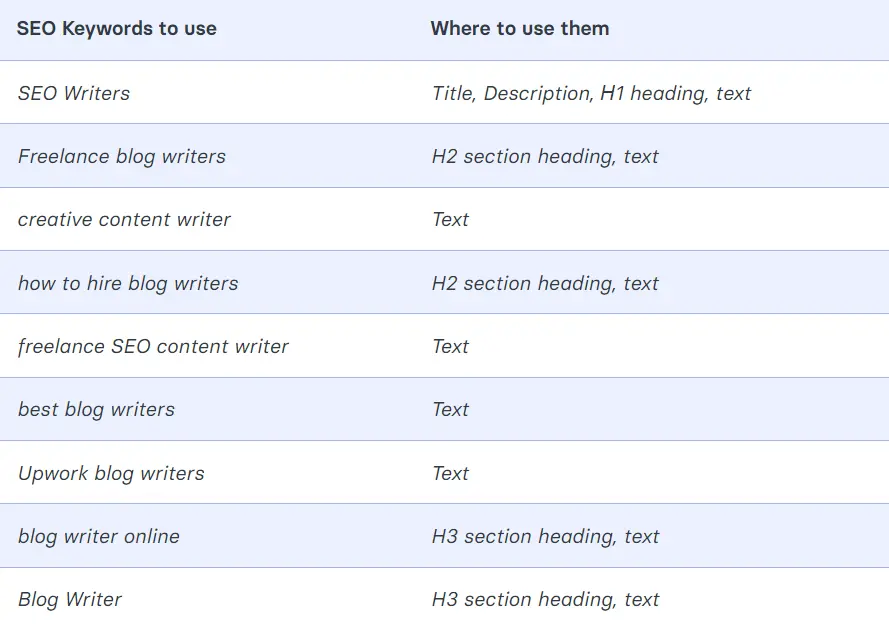
A List of Suggested Internal and External Links
In some cases, internal links can point to subtopics that need further explanation or discussion on a separate page. External links, on the other hand, can be used to provide additional context, reference authoritative sources, or offer complementary perspectives. Both types of links enhance the user experience by offering a more comprehensive understanding of the topic and improving the credibility of your content.
Text Formatting Rules
For editors aiming to enhance their content marketing briefs, incorporating specific rules can significantly improve the clarity and impact of the final piece. Here's a snapshot of these valuable guidelines:
- Subtitles are a must for every 300 words.
- Bold keywords sparingly.
- Paragraphs should be concise, 3-5 sentences each.
- Aim for 90% text uniqueness.
- Use lists, bullets, and tables for clarity.
- Cite sources, especially for statistics.
- Section articles into digestible 100-300 word chunks.
- H1 should feature the primary keyword and be distinct from the title.
- Titles need to be keyword-focused without ending in a full stop.
- Meta descriptions should be concise, keyword-rich, and engaging.
- Integrate keywords naturally within the article.
- Correct any misspelled keywords in the text.
- Subheadings (H2-H6):
- Limit to 70 characters.
- Ensure headings are descriptive for easy scanning.
These rules not only streamline the writing briefs but also optimize content for both readers and search engines.
Using GPT-4 to Create a Content Brief
AI still has significant strides to make before it can independently manage creative and strategic undertakings without human guidance, such as authoring content briefs. Tools like GPTChat, however, can be beneficial, simplifying and speeding up many aspects of content brief writing. With tools like Serpstat now integrated into ChatGPT, keyword and topic research can also be accomplished within the platform. In addition, chat functionality makes this analysis much more accessible to people without a research background.
Serpstat SEO plugin brainstorming keyword ideas
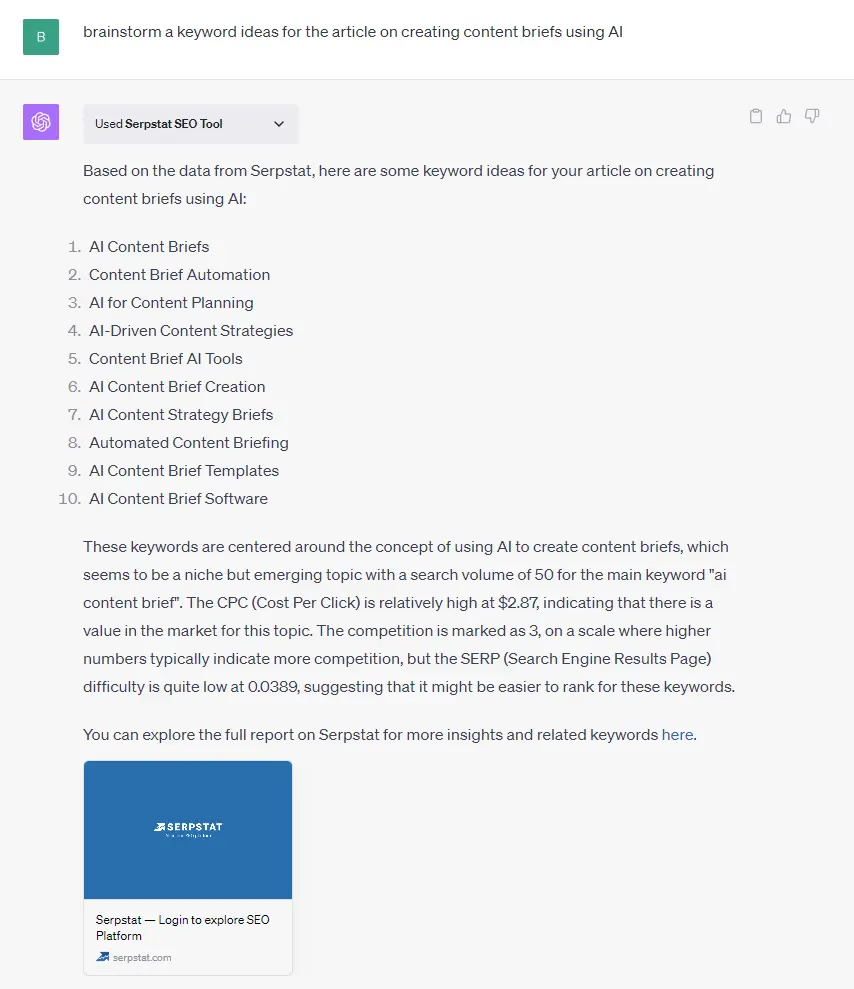
Within Serpstat, you will also find more options for filtering, sorting, and determining the number of results (the plugin displayed a maximum of 50 phrases). Thus, you can select keywords by topic and get recommendations for choosing similar phrases, search suggestions, and queries in question form.
To сraft a content brief using AI, it's crucial to consider these strategic factors:
GPT-4 offers more creativity but still retains an AI-like tone.
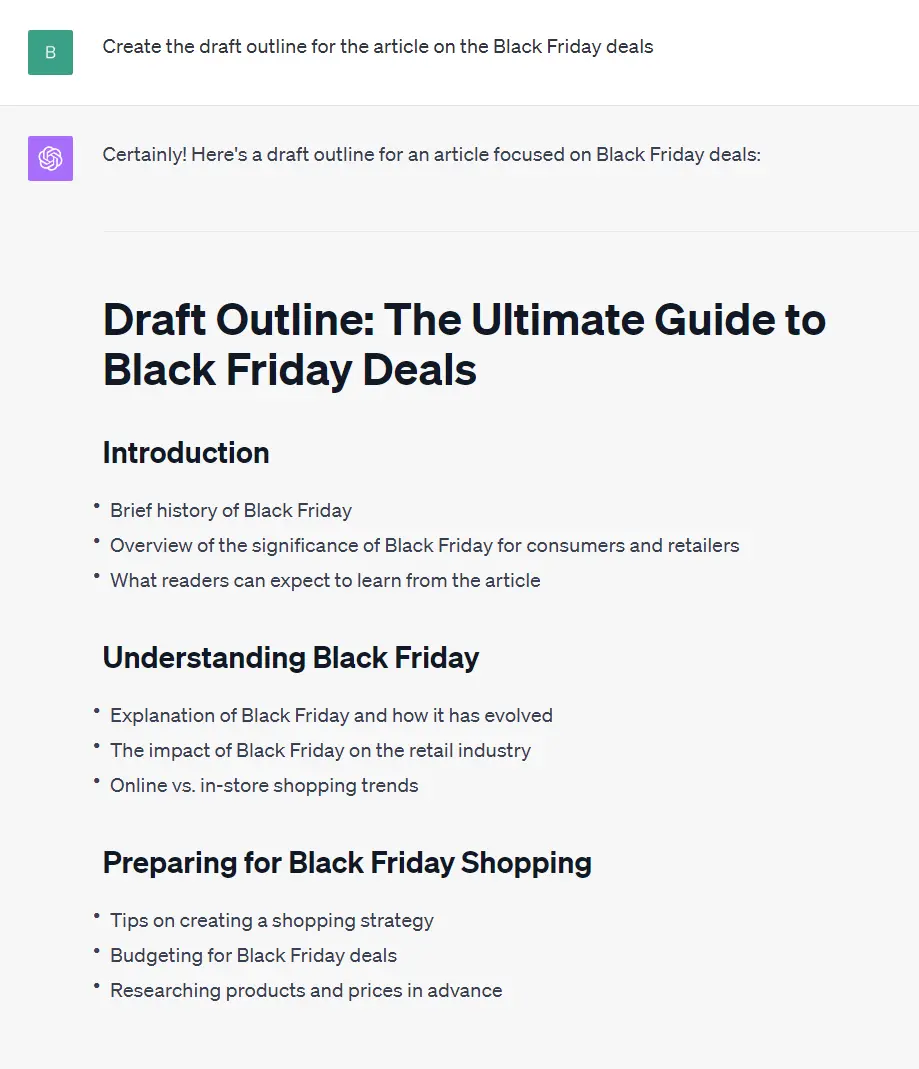
The best idea for the table of contents is to keep the human touch and make the analysis of the competitive site’s structure at the Top of SERP. It’s also possible using Serpstat functionality:
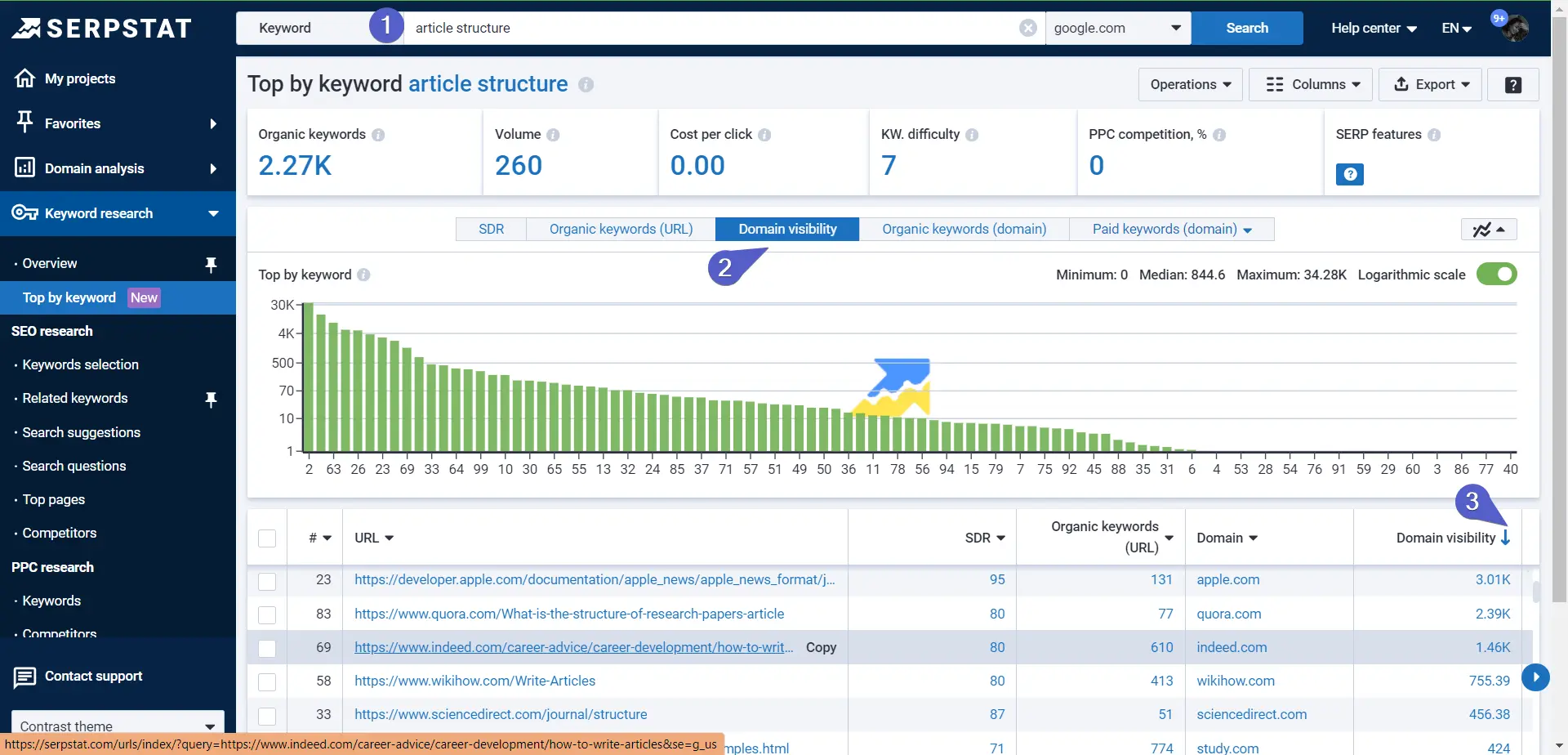
Well-crafted contextual prompt by Philippe De Ridder

AI can structure your brief by recommending optimal keyword placement, suggesting meta tags, and even forecasting your content's effectiveness. But there are also non-obvious use-cases. One of my latest discoveries can be helpful for a creative brief generator:
AI-driven YouTube transcription can guide the copywriter for the content based on the webinar or product video:
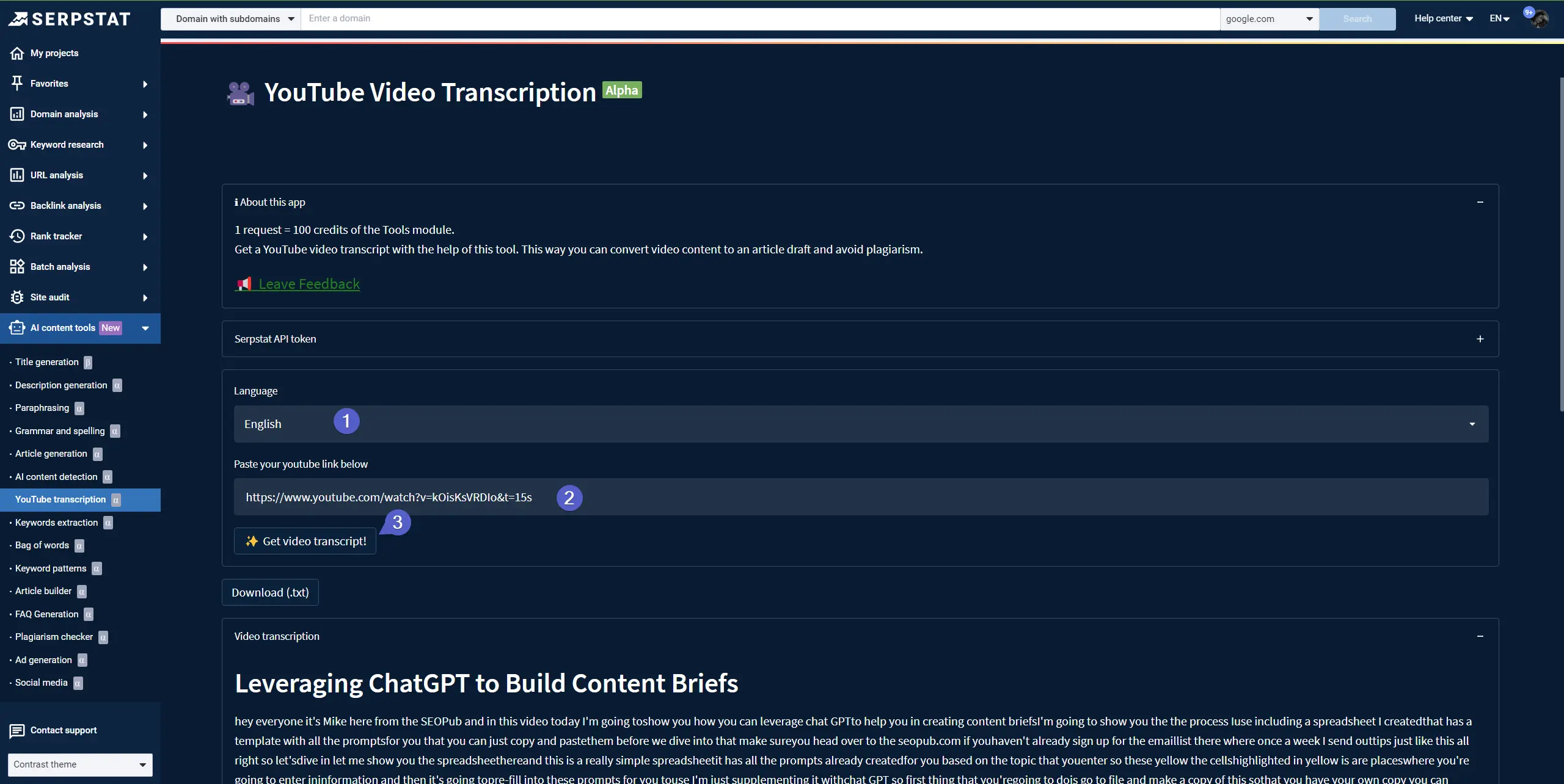
Then you can then ask GPTChat to transform the text into a readable format or summarize it:
Prompting to transform the transcription of the video
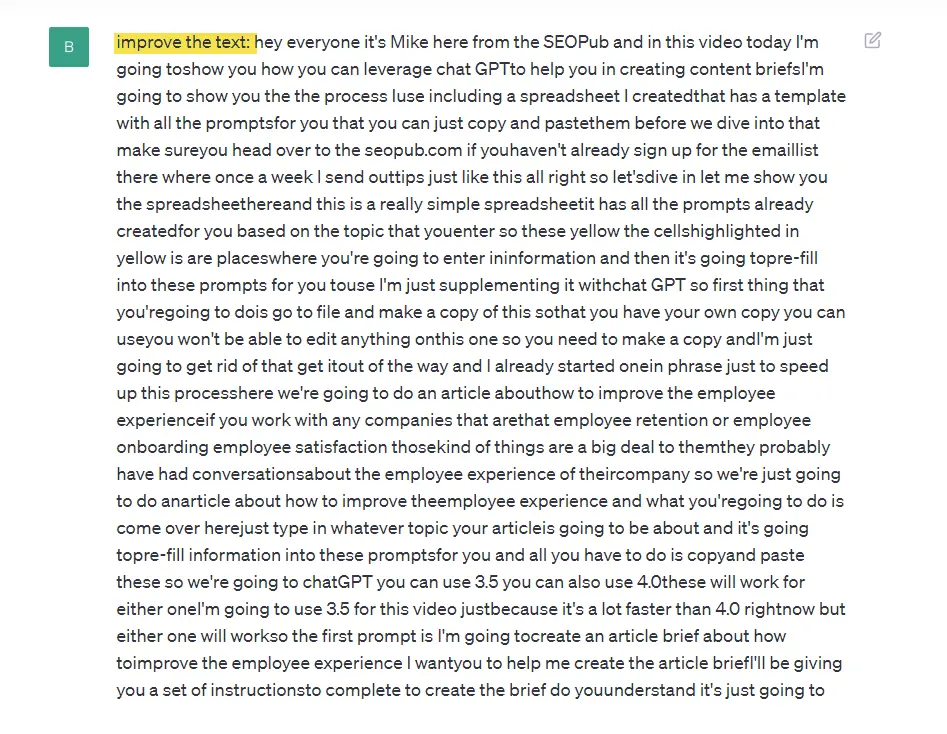
The improved text to add to the ready-made content brief as a reference
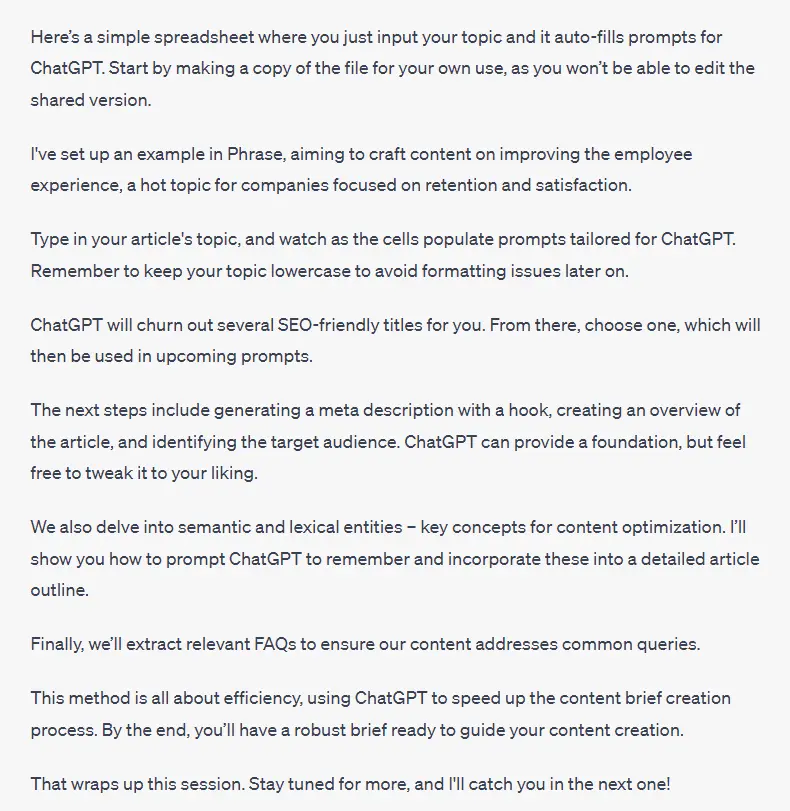
By understanding the types of queries that lead users to your site, AI can help tailor your content to meet those needs directly. This increases the likelihood of higher engagement and conversion rates.
AI-generated SEO content brief templates streamline the process, allowing you to focus on crafting content that resonates with your audience while adhering to SEO best practices. However, using these tools for content briefs should be approached as ethically and responsibly as using any other resource. AI content brief can enhance productivity but has limitations that require human oversight to ensure content coherence. Furthermore, ChatGPT tends to hallucinate, so verify everything before hitting publish. AI should be seen as a starting point for initial ideas, which then should be built upon with personal insights. Using AI effectively also involves focusing on the audience and integrating relevant information into the content creation.
Conclusion: The Future of Content Briefs
Сontent brief is the foundation upon which successful content is built. When crafted carefully, it's a strategic tool that can lead your content through the competitive digital landscape to achieve the visibility and engagement it deserves.
A good content brief should be simple. It needs to cover the essential information required by the author without drowning them in SEO jargon or stripping away their freedom to write in the way they deem best.
Leveraging AI for content briefs offers numerous advantages, making it a savvy choice for streamlining your workflow. However, to fully capitalize on these perks, understanding how to collaborate with artificial intelligence effectively is essential.
FAQ
An SEO content brief streamlines content production by providing clear, concise instructions, ensuring team alignment with campaign goals and strategic consistency. It helps maintain uniformity in brand messaging, tone, and audience targeting, which is crucial for engaging readers and prompting action through CTAs. This approach saves time and minimizes the need for extensive rewrites.
Google Search does not inherently penalize content produced by AI. The measure's target is AI-generated content intended to manipulate search engine algorithms. As long as your content is unique and provides value, it should perform well in search results, irrespective of its creation method.
Discover More SEO Tools
Text Analysis Tool
Unlock the power of your text data with our advanced Text Analytics Tools
AI Content Detection
Ai Content Checker – realize if the text is AI-generated
AI Text Generator
Try our AI Content Writer tool and streamline your content creation process
AI Content Tools
AI Content Marketing Tools – simplify and optimize the content creation process
Recommended posts
Cases, life hacks, researches, and useful articles
Don’t you have time to follow the news? No worries! Our editor will choose articles that will definitely help you with your work. Join our cozy community :)
By clicking the button, you agree to our privacy policy.


